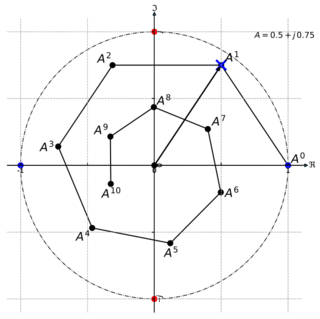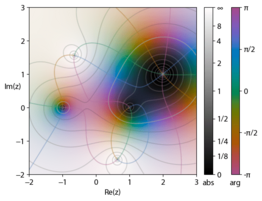Complex analysis facts for kids
Complex analysis is a part of mathematics that studies functions of complex numbers. Think of it as a special kind of math that deals with numbers that have both a "real" part and an "imaginary" part.
This field of math is super useful! It helps in many areas of mathematics like algebraic geometry and number theory. It's also important in physics, for understanding things like how fluids move (hydrodynamics) and the tiny world of quantum mechanics. Engineers in fields like aerospace and electrical engineering also use complex analysis.
A key idea in complex analysis is the study of holomorphic functions. These are special functions that can be "differentiated" (a calculus term for finding how a function changes) in a very smooth way. If a function can be differentiated in this special way, it's also "analytic," meaning it can be described by an endless sum of simpler terms called a Taylor series.
Contents
History of Complex Analysis

Complex analysis is an old and important part of mathematics. Its beginnings go back to the 1700s. Some of the most famous mathematicians who worked on complex numbers include Euler, Gauss, Riemann, and Augustin-Louis Cauchy. Many more mathematicians in the 20th century also added to this field.
This area of math, especially the study of conformal mappings (which are ways to transform shapes while keeping their angles the same), has many uses in physics. It's also used in analytic number theory, which combines ideas from calculus with the study of whole numbers.
More recently, complex analysis has become popular again thanks to complex dynamics. This field creates amazing fractal pictures by repeating certain mathematical steps with holomorphic functions. Complex analysis is also important in string theory, which is a theory in physics that tries to explain how the universe works.
What are Complex Functions?

A complex function is a function that takes a complex number as input and gives a complex number as output.
Imagine a complex number like a point on a special graph called the complex plane. This point has two parts: a "real" part (like an x-coordinate) and an "imaginary" part (like a y-coordinate).
When you put a complex number, let's call it z, into a complex function, say f(z), the output f(z) will also be a complex number. We can write z as x + iy, where x is the real part and y is the imaginary part. The function f(z) will then have its own real part, u(x,y), and imaginary part, v(x,y).
So, a complex function essentially takes two real numbers (x and y) and gives you two other real numbers (u and v).
Some basic ideas, like whether a function is continuous (meaning it doesn't have any sudden jumps), are similar for complex functions as they are for functions of real numbers. But other ideas, like being "differentiable" (smooth enough to find a derivative), are much stronger for complex functions.
For example, if a complex function can be differentiated, it's also "analytic." This means it can be written as an infinite sum of terms, like a very long polynomial. This is different from real functions, where a function can be differentiated many times but still not be analytic. Many common functions, like the complex exponential and trigonometric functions, are defined this way for complex numbers.
Holomorphic Functions
Complex functions that can be "differentiated" (meaning you can find their slope or rate of change) at every point in a certain area of the complex plane are called holomorphic functions.
The way we define the derivative for complex functions looks similar to how we do it for real functions. However, for a complex derivative to exist, the function must be very smooth and behave consistently no matter which direction you approach a point from in the complex plane.
This makes complex differentiability much more powerful than real differentiability. For instance, if a complex function is holomorphic, it can be differentiated an infinite number of times! Also, holomorphic functions are always "analytic," meaning they can be perfectly described by a power series (like an endless polynomial) around any point in their domain. This is a big difference from real functions, where a function can be differentiated many times but still not be analytic.
Most basic functions you know, like the exponential function, trigonometric functions, and all polynomial functions, are holomorphic everywhere in the complex plane. These are called entire functions. Functions that are holomorphic everywhere except at a few isolated points (where they might "blow up") are called meromorphic functions.
However, some simple-looking functions, like finding the real part of a complex number or its absolute value, are not holomorphic anywhere.
A key feature of holomorphic functions is a set of equations called the Cauchy–Riemann conditions. These equations show a special relationship between the real and imaginary parts of a holomorphic function. If a function f(z) = u(x,y) + iv(x,y) is holomorphic, then the way u changes with x must be the same as how v changes with y, and the way u changes with y must be the opposite of how v changes with x.
Holomorphic functions have some amazing properties. For example, Picard's theorem says that an entire function (one that's holomorphic everywhere) can only have three possible sets of output values: all complex numbers, all complex numbers except one, or just a single complex number. This means if an entire function never produces two different complex numbers as outputs, then it must be a constant function!
Also, if you know the values of a holomorphic function in a small area, you can figure out its values everywhere else in its connected domain. This idea is called analytic continuation.
Conformal map
Major Results in Complex Analysis
One of the most important tools in complex analysis is the line integral. Imagine drawing a closed path, like a circle, in the complex plane. If a function is holomorphic everywhere inside and on this path, then the line integral of that function around the path will always be zero. This is stated by the Cauchy integral theorem.
The values of a holomorphic function inside a circle can also be found by doing a special line integral along the circle's edge. This is called Cauchy's integral formula. These line integrals are often used to solve complicated integrals that come up in real-world problems.
Sometimes, a function might have a "pole" (also called an isolated singularity). This is a point where the function's value becomes extremely large, or "blows up." If a function has such a pole, you can calculate its "residue" there. This residue is a special number that helps you compute line integrals involving the function. This is the idea behind the powerful residue theorem. Functions that only have poles but no other types of "bad" points are called meromorphic functions.
The amazing behavior of holomorphic functions near very tricky points (called essential singularities) is described by Picard's theorem.
Another important result is Liouville's theorem. It states that if a function is holomorphic everywhere in the complex plane and its values are "bounded" (meaning they don't go off to infinity), then the function must be a constant. This theorem can be used to prove the Fundamental Theorem of Algebra, which says that every polynomial equation with complex numbers has at least one complex solution.
If a function is holomorphic in a connected area, its values are completely determined by its values in any smaller part of that area. This allows us to "analytically continue" functions. For example, the Riemann zeta function is first defined by an infinite sum that only works in a limited area. But using analytic continuation, we can extend its definition to almost the entire complex plane.
Sometimes, like with the natural logarithm, you can't extend a holomorphic function to certain complex areas directly. But you can extend it to a special surface called a Riemann surface, where it behaves nicely.
All these ideas are about complex analysis with just one variable. But there's also a very rich field called complex analysis in more than one complex dimension. In this field, properties like power series expansions still hold, but many of the geometric properties of single-variable holomorphic functions (like keeping angles the same) do not. For example, the Riemann mapping theorem, which is very important in one dimension, doesn't work in higher dimensions.
Complex numbers and complex spaces are also very important in quantum mechanics, where they are used to describe wave functions.
See also
 In Spanish: Análisis complejo para niños
In Spanish: Análisis complejo para niños
- Complex geometry
- Hypercomplex analysis
- Vector calculus
- List of complex analysis topics
- Monodromy theorem
- Real analysis
- Riemann–Roch theorem
- Runge's theorem


